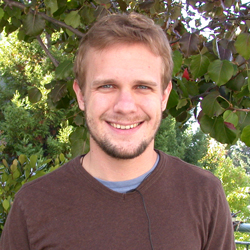
Dave Mets - Post-Doctoral Researcher
125 Koshland Hall
(510) 642-1263
dmets@berkeley.edu
Mailing Address:
University of California Berkeley
16 Barker Hall, MC 3204
Berkeley, CA 94720-3204
 |
Dave Mets - Post-Doctoral Researcher 125 Koshland Hall Mailing Address: |
| Research Summary |
| In many organisms, the genetic positions of crossovers display an interference pattern, such that one crossover decreases the likelihood of a second crossover on the same chromosome. In C. elegans, crossover interference is extreme; one crossover event occurs per homolog pair per meiosis. Dosage compensation components DPY-28 and DPY-26, homologs of the condensin subunits XCAP-D2 and XCAP-H, respectively, are critical for complete interference. Both DPY-28 and DPY-26 are enriched in germline nuclei during initiation of recombination. Mutations in dpy-28 and dpy-26 disrupt interference and increase recombination on both the X chromosome and the autosomes. Consistent with the increase in crossover frequency, the number of RAD-51 foci in meiotic nuclei is increased in dpy-28 and dpy-26 mutants. RAD-51 foci form at sites of resected double strand breaks (DSBs). These extra foci are dependent upon the meiotc DSB machinery, suggesting that these extra RAD-51 foci represent bona fide meiotic DSBs. To examine where DPY-26 and DPY-28 might act in the progression from a DSB to a crossover, we developed a terminal-transferase assay (tunel). This assay permits cytological identification of DSBs. dpy-26 and dpy-28 mutations cause an increase in the number of tunel foci throughout meiotic prophase, but the most substantial increase appears during leptotene/zygotene, indicating that more DSBs are formed in dpy-26 and dpy-28 mutants. To determine if the crossover phenotypes seen in these mutants can be attributed simply to increased DSB formation, we are conducting crossover analysis in animals exposed to gamma-irradiation. DPY-26 immuno-precipitations from whole worm extract were performed and mass-spec analysis was used to identify proteins that may act with DPY-26 in the germline. DPY-28 and several other proteins were identified. Mutations in genes encoding the identified proteins cause an increase in RAD-51 foci during pachytene, bututations in dosage-compensation-specific genes that encode DPY-26 interacting proteins do not. In summary we have shown that DPY-26 and DPY-28 regulate crossover distribution, frequency, and the number of recombination events initiated in meiosis. Our work has also identified candidates that may contribute to crossover control. |
| Publications/Presentations |
| Tsai, C.J., Mets, D.G., Albrecht, M.R., Nix, P., Chan, A., Meyer, B.J. (2008) Meiotic crossover number and distribution are regulated by a dosage compensation protein that resembles a condensin subunit. Genes & Development 22, 194-211.
Morris Z.S., Hanson D.K., Pokkuluri P.R., Mets D.G., Hata A.N., Poluektov O.G., Thurnauer M.C., Schiffer M., Laible P.D. (2003) Lysine substitutions near photoactive cofactors in the bacterial photosynthetic reaction center have opposite effects on the rate of triplet energy transfer. Chemical Physics 294, 329-346. |
| Education |
| 2002-2008 University of California, Berkeley Ph.D., Molecular and Cell Biology 1998-2002 |